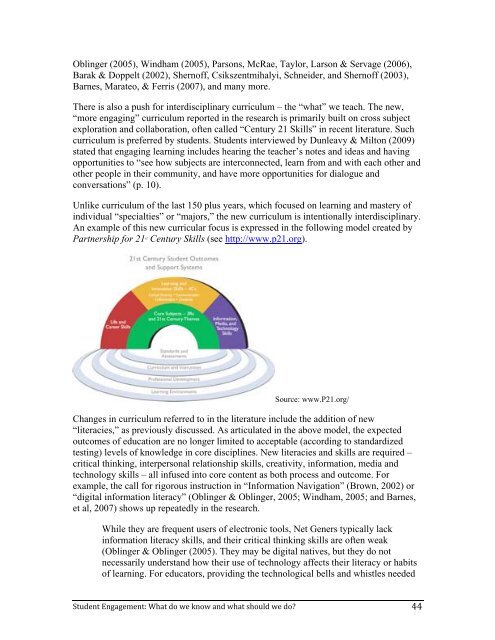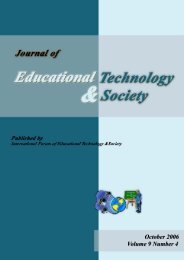Student Engagement: What do we know and what should we do?
Student Engagement: What do we know and what should we do?
Student Engagement: What do we know and what should we do?
Create successful ePaper yourself
Turn your PDF publications into a flip-book with our unique Google optimized e-Paper software.
Oblinger (2005), Windham (2005), Parsons, McRae, Taylor, Larson & Servage (2006),<br />
Barak & Doppelt (2002), Shernoff, Csikszentmihalyi, Schneider, <strong>and</strong> Shernoff (2003),<br />
Barnes, Marateo, & Ferris (2007), <strong>and</strong> many more.<br />
There is also a push for interdisciplinary curriculum – the “<strong>what</strong>” <strong>we</strong> teach. The new,<br />
“more engaging” curriculum reported in the research is primarily built on cross subject<br />
exploration <strong>and</strong> collaboration, often called “Century 21 Skills” in recent literature. Such<br />
curriculum is preferred by students. <strong>Student</strong>s intervie<strong>we</strong>d by Dunleavy & Milton (2009)<br />
stated that engaging learning includes hearing the teacher’s notes <strong>and</strong> ideas <strong>and</strong> having<br />
opportunities to “see how subjects are interconnected, learn from <strong>and</strong> with each other <strong>and</strong><br />
other people in their community, <strong>and</strong> have more opportunities for dialogue <strong>and</strong><br />
conversations” (p. 10).<br />
Unlike curriculum of the last 150 plus years, which focused on learning <strong>and</strong> mastery of<br />
individual “specialties” or “majors,” the new curriculum is intentionally interdisciplinary.<br />
An example of this new curricular focus is expressed in the following model created by<br />
Partnership for 21 st Century Skills (see http://www.p21.org).<br />
Source: www.P21.org/<br />
Changes in curriculum referred to in the literature include the addition of new<br />
“literacies,” as previously discussed. As articulated in the above model, the expected<br />
outcomes of education are no longer limited to acceptable (according to st<strong>and</strong>ardized<br />
testing) levels of <strong>know</strong>ledge in core disciplines. New literacies <strong>and</strong> skills are required –<br />
critical thinking, interpersonal relationship skills, creativity, information, media <strong>and</strong><br />
technology skills – all infused into core content as both process <strong>and</strong> outcome. For<br />
example, the call for rigorous instruction in “Information Navigation” (Brown, 2002) or<br />
“digital information literacy” (Oblinger & Oblinger, 2005; Windham, 2005; <strong>and</strong> Barnes,<br />
et al, 2007) shows up repeatedly in the research.<br />
While they are frequent users of electronic tools, Net Geners typically lack<br />
information literacy skills, <strong>and</strong> their critical thinking skills are often <strong>we</strong>ak<br />
(Oblinger & Oblinger (2005). They may be digital natives, but they <strong>do</strong> not<br />
necessarily underst<strong>and</strong> how their use of technology affects their literacy or habits<br />
of learning. For educators, providing the technological bells <strong>and</strong> whistles needed<br />
<strong>Student</strong> <strong>Engagement</strong>: <strong>What</strong> <strong>do</strong> <strong>we</strong> <strong>know</strong> <strong>and</strong> <strong>what</strong> <strong>should</strong> <strong>we</strong> <strong>do</strong>? 44












